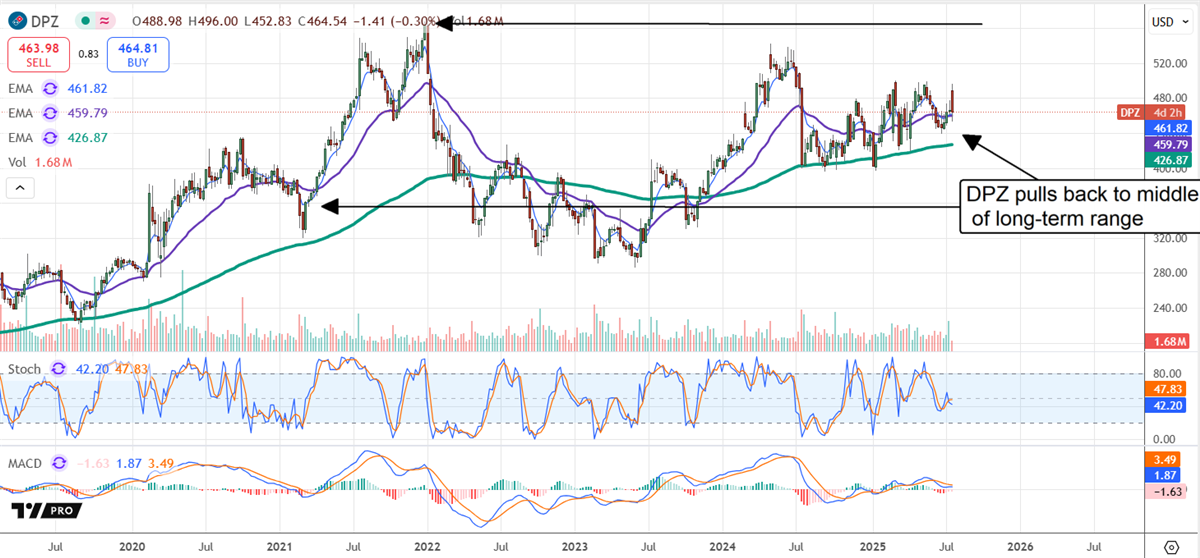| Written by Thomas Hughes 
Domino’s (NASDAQ DPZ) FQ2 results were weak, underperforming reduced expectations, with growth slowing and earnings in contraction, but that is not what investors should focus on. Those negative details are short-lived headlines that do not offset the increase, profits, improved business leverage, and substantial capital return. Nevertheless, a knee-jerk reaction from the market led to a fall in DPZ share prices—putting it back into attractive territory where buy-and-hold investors are likely to scoop it up. Institutional investor data tracked by MarketBeat suggests the group is likely to buy on the late-July price pullback. The group bought on balance in Q1 and Q2, as well as in the first weeks of July, netting nearly $2 in shares for every one sold, providing solid support for the market. Institutional support is significant as they own nearly 95% of the shares and are expected to continue buying. Domino’s Builds Leverage in Q2 While Domino’s faces some headwinds in 2025—particularly around input costs and margin compression—it continues to grow its store count and comparable sales, boosting operating leverage. Domino's Q2 revenue was as expected at $1.15 billion, up 4.7% on a constant currency basis, with strength across all segments. Global Retail sales grew by 5.6% on a combination of store count and comp-store growth, in-store and delivery options. Store count improved by nearly 1%, U.S. comps grew by 3.4%, and International comps by 2.4% aided by market share gains. The margin is the sticking point for investors in 2025. The company improved income from operations but net contracted, resulting in a 5.5% decrease in GAAP EPS, driven by increased input costs and insurance expenses. The good news is that the earnings are sufficient to sustain the balance sheet health while investing in growth and returning capital, including dividend distribution and share buybacks. 
Share buybacks reduced the count by nearly 1% on a year-to-date (YTD) basis and are expected to continue as the year progresses. The dividend yields approximately 1.5%, which is slightly better than the broad market average. It is reliable and accounts for roughly 40% of the earnings forecast reported by MarketBeat. Domino’s executives didn’t provide guidance but offered a favorable outlook, citing best-in-industry unit metrics and an ability to drive long-term value for franchisees and investors. Analysts' Support for DPZ Aligns With Institutional Trends While analyst sentiment in 2025 has moderated slightly, evidenced by some price target reductions, the overall tone remains constructive. The 26 analysts tracked by MarketBeat forecast steady mid-single-digit revenue growth compounded by accelerated and accelerating earnings growth through the middle of the next decade. Earnings growth is forecasted to exceed 10%, with July stock prices valuing the business at a significant discount of only 10 times the 2035 forecast. Analysts have given DPZ stock a Moderate Buy rating and view the stock as fairly valued. A move to the low end of the trading range is possible, but new lows are unlikely without a change to the outlook, which is unexpected. The likely outcome is that DPZ price action will remain range-bound in 2025. The opportunity is to load up on shares when they are low in the range, building a position for when macroeconomic headwinds subside and tailwinds can blow. In this scenario, DPZ shares will continue to pay their dividend while the company reduces the share count and builds store count and brand leverage.  Read This Story Online Read This Story Online |  |
| Written by Sam Quirke 
Shares of Tesla Inc (NASDAQ: TSLA) have been rallying hard since April’s low, gaining more than 50% in that timeframe. A 3% pop last Friday added to the momentum, and the chart is showing signs of an explosive move in the near term. After a multi-month stretch of tightening consolidation, Tesla is now coiled in a bullish pennant formation that looks ready to come to a head as the automotive giant heads into arguably its most important earnings report of the year. The “test” for Tesla isn’t just what gets reported this Wednesday; it’s whether the stock can find the momentum to punch through resistance. With both the bulls and the bears drawing their battle lines, this week’s report could be the catalyst defining the rest of Tesla’s year. Bullish Chart & MACD Crossover Signal Potential Tesla Breakout to $350–$370 The good news for those of us on the sidelines is that Tesla’s chart looks bullish going into the report. Since April, there has been a clear pattern of higher lows, as the bears have been unable to check the upward progress. At the same time, there have been some lower highs, which may be to Tesla’s advantage. The narrowing range they’ve formed has created a textbook pennant formation, and as the company approaches its earnings, the pattern is nearing its apex. A bullish MACD crossover late last week supports the thesis that momentum is building on the bull’s side, and a strong earnings report could be just the ticket to send shares breaking out to the north. If that happens, the $350–$370 zone is very much in play. A move through that level would confirm the uptrend isn’t just intact, it’s gaining strength. Tesla Forecasts Revenue & Earnings Decline, Yet Stock Poised for Upside Surprise Tesla is forecast to report a year-over-year drop in revenue and earnings, with vehicle deliveries already confirmed to be down meaningfully from last year. This is reflected in how many on Wall Street have taken a cautious stance, but it also sets the stock up nicely for an upside surprise. Tesla has missed on earnings more often than not in recent quarters, and most recent EPS revisions have been to the downside. Recent ratings lean more towards Hold or Sell, rather than Buy, which makes Tesla a dangerous stock to bet against. Don’t forget that the company delivered a massive miss on the headline numbers in April’s report, then went on to rally more than 60% almost unchecked. AI Roadmap & Robotaxi Buzz Could Spark Tesla’s Next Rally Additional fuel for the rally might come in the form of fresh updates from CEO Elon Musk on Tesla’s AI roadmap, including the integration of its Grok chatbot into the Optimus humanoid robot and potentially even into Tesla vehicles themselves. There’s also been the much-hyped robotaxi launch, and comments around that could easily become the main story, with investors watching for any updates about additional monetization potential or the regulatory progress. If Wednesday’s update were to add clarity to the company’s multiple ambitions, it should be enough to kick off the next leg of the rally. Frothy P/E Meets Bullish MACD Crossover: Is Tesla Poised for a Breakout? It’s worth noting, though, that Tesla’s P/E ratio sits near 180, frothy by any definition, especially with profit and revenue expected to decline year over year. However, the bulls will argue that Tesla is no longer just an EV company but an AI and energy infrastructure play with massive potential. To sustain that narrative, though, Tesla must prove it can deliver meaningful innovation and execution, especially in a tougher macro and competitive environment. For now, though, the bulls have the momentum, and the chart looks healthy. Last week’s bullish crossover of the MACD might well have been the best signal yet that the tightening pennant will be broken by the stock breaking out to the north.  Read This Story Online Read This Story Online |  My top income trading expert, Dave Aquino, just released a 1-hour trading strategy designed specifically to help regular investors generate enough income to become financially independent…
Without taking on excessive amounts of risk.
I'm talking about having the opportunity to collect $500 on Monday…
$563 on Wednesday…
Then as much as $625 on Friday. Click here to reserve a copy and put yourself on the path to better trading. |
| Written by Sam Quirke 
Wall Street just wrapped up a big week for earnings in the financial sector, and if there's one clear thing, it's that not all banks are built the same right now. With rising interest rates no longer the tailwind they once were, and margin pressure becoming a theme, investors are quickly drawing lines between the winners and the also-rans. While all three major bank stocks profiled below have rallied strongly since April, their post-earnings setups diverge rapidly. Let's see which ones are worth chasing and which might be best avoided. Goldman's Rally Might Be Running Out of Steam Of the three, Goldman Sachs Group Inc (NYSE: GS) is the best performer since April, up more than 60% and now consolidating just below all-time highs. On paper, there's a lot to like. The company has just delivered a solid set of Q2 earnings, beating analyst expectations and showing revenue growth of 15% year-over-year. Valuation-wise, it's also solid with a P/E ratio of around 15, not too hot and not too cold. But there's a sense that much of the good news is already priced in. Despite the headline beat, the stock's reaction was muted. Several analysts called it a Hold in the aftermath of Wednesday's report, with Market Perform and Equal Weight ratings dominating the commentary. While shares are still below many of the refreshed price targets, the lack of urgency suggests the near-term upside might be limited unless Goldman can show another gear. There's no question this has been the hottest bank stock of the past few months, but it's also starting to feel like a lot of the easy gains have already been made. Morgan Stanley Has the Momentum Shares of Morgan Stanley (NYSE: MS) haven't rallied quite as much as Goldman's, but its post-earnings setup looks more interesting. Interestingly, though, shares did drop sharply after Wednesday's earnings release, falling as much as 4% before recovering and finishing Thursday in the green. However, the fact that the dip was so quickly bought up points to a strong undercurrent of demand for the stock right now. Heading into the year's second half, there's a lot to like about Morgan Stanley. Fundamentally, the company exceeded earnings expectations this week, with revenue up nearly 12% year-over-year. Management has also been stepping up with shareholder-friendly moves, including a dividend increase and a larger buyback program. The analyst reaction has also been more encouraging than Goldman's, with Keefe Bruyette & Woods upgrading the stock to Outperform earlier this month. The stock's chart is solid, the fundamentals are improving, and the Street is starting to warm up. If you're looking for the name with the most near-term upside potential, this is probably it. Bank of America Still Has Work to Do Bank of America Corp. (NYSE: BAC) has also had a decent run over the past few months, rallying more than 40% since April. However, unlike its peers, it's still trading below its 2022 all-time high, which says a lot. Furthermore, the bank missed revenue expectations in its Q2 report this week, likely weighing on sentiment for the foreseeable future. Investors have had reason to be skeptical, and for now, at least, their skepticism appears justified. While the broader financial sector has been enjoying a bright spell, Bank of America continues to lag its peers on both technicals and fundamentals. There's no real breakout narrative here, and the market seems to know it. To its credit, Bank of America is the cheapest of the three, trading at a P/E ratio of about 13. If you're a deep-value investor willing to stomach more risk, a long-term case must be made. However, in the near term, there are simply better options.  Read This Story Online Read This Story Online |  |
|
0 Response to "🦉 The Night Owl Newsletter for July 21st"
Post a Comment